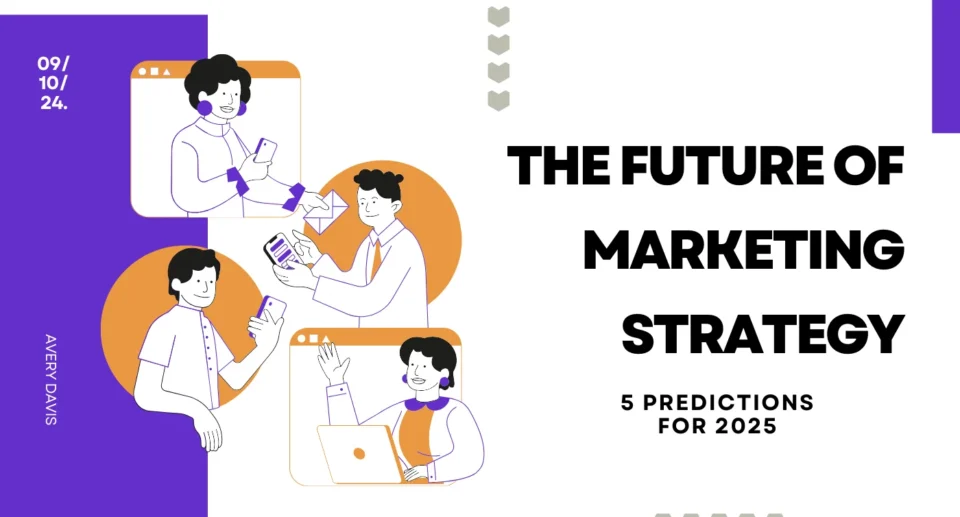The Future of Marketing Strategy: 5 Predictions for 2025
Jay Pathak
- May 9, 2025
- 5 Min Read

If the last few years have taught marketers anything, it’s this: you blink, and everything changes.
In 2020, we were figuring out how to pivot campaigns during a pandemic. In 2022, everyone rushed into short-form video. In 2023 and 2024, AI flipped the marketing playbook on its head. And now, standing in 2025, we’re staring down a whole new kind of battlefield — one that’s faster, noisier, and more algorithmically controlled than ever before.
So, what’s next?
If you’re still stuck thinking marketing is about “posting consistently” or “running Facebook ads,” let’s just say this isn’t your mom’s marketing strategy anymore.
Let’s unpack what 2025 has in store. Here are five bold predictions that are already reshaping the future of marketing — and how smart brands are getting ready for it.
1. First-Party Data Will Be Your Brand’s New Currency
You’ve probably heard this a dozen times by now, but let’s be clear: cookies are crumbling. With privacy regulations tightening and third-party tracking on its last leg, marketers who relied on renting data are being forced to own it.
What does this mean in 2025?
✅ Building email lists is back in style.
✅ Zero-party data (the stuff customers willingly give) is gold.
✅ Interactive content like quizzes, gated tools, and surveys will become lead-gen staples.
✅ Loyalty programs are no longer just “nice to” have”—they’re data engines
In short, if you’re not investing in first-party data infrastructure, you’re gambling with your growth.
Pro Tip: Stop chasing cold leads. Instead, build ecosystems (think: community, newsletters, gated content) that invite users to share info in exchange for real value.
2. Marketing Teams Will Start Looking a Lot More Like Product Teams
The line between product and marketing is blurring. Actually, it’s vanishing.
Today’s marketers aren’t just storytellers —they’re UX nerds, data interpreters, AI prompt engineers, and growth hackers rolled into one.
By 2025, you’ll see more marketing teams structured like agile product squads. Think sprints. Think iterations. Think rapid A/B testing and tight feedback loops.
The most successful marketing teams won’t be the ones with the biggest budgets — they’ll be the ones who treat campaigns like experiments and optimize them like code.
Pro Tip: If your current marketing workflow involves months-long planning cycles and static annual calendars, it’s time to get uncomfortable — or get left behind.
3. AI Will Handle the Execution — But Humans Will Drive the Ideas
Let’s get this straight: AI isn’t coming for your job. But it is coming for the parts of your job that are slow, repetitive, and uninspired.
In 2025, AI is already helping marketers:
- Generate ad copy variations in seconds
- Build on-brand images and videos (thanks, DALL·E and Runway!)
- Summarize insights from customer feedback
- Draft landing pages and emails at scale
But here’s the catch: it still sucks at context. AI can create, but it can’t choose. It can write 10 headlines — but only you know which one resonates with your audience. It can design a layout — but it can’t feel whether it works.
This is where the creative strategist shines.
Pro Tip: Don’t fight AI — train it. Feed it your tone of voice, your best-performing content, and your personas. Then let it handle the grunt work while you lead the creative charge.
4. Brand Purpose Will Become a Conversion Driver, Not Just a Tagline
A few years ago, “purpose-driven branding” was treated like a soft metric — nice in theory, hard to measure.
Fast-forward to 2025, and brand values are part of the buyer’s decision-making process — especially among Gen Z and Gen Alpha. They want to know what you stand for before they hand over their money.
This doesn’t mean you need to launch a mission campaign every month. It means your values should be baked into:
- How your website talks
- What your social content prioritizes
- Which influencers you partner with
- How your product is positioned
Purpose isn’t something you bolt on — it’s something you build into your entire strategy.
Pro Tip: Don’t fake it. Audiences can smell performative branding from miles away. Choose a stand you actually believe in — and back it up with action.
5. Micro-Communities Will Beat Mass Reach
Gone are the days when you needed a million followers to win. In 2025, the smartest brands are going narrow, not broad.
Instead of trying to go viral, they’re building micro-communities of 1,000 true fans. Niche Discord groups. Private LinkedIn circles. Product-specific subreddits. Community-led email lists.
Why? Because trust is tanking. Social platforms are noisy. Ads are getting ignored. But conversations still convert — especially when they’re happening in intimate, high-trust environments.
Community-driven marketing isn’t about shouting louder. It’s about showing up where your people already are and creating real connection.
Pro Tip: Build community before you sell. Be the space where your audience finds value, not just offers.
Bonus Thought: Strategy Isn’t Dead — It’s Just Evolving
Let’s address the elephant in the chat: Yes, tools are getting smarter. Platforms are getting faster. But strategy still matters more than ever.
The brands that win in 2025 will be the ones that:
- Understand their audience deeply
- Adapt their strategy constantly
- Build systems instead of just campaigns
- Use tech without losing their soul
Whether you’re running a lean startup or managing a full-blown enterprise, the future of marketing belongs to those who blend insight + instinct + iteration.
Final Word
Marketing in 2025 isn’t about being everywhere. It’s about being right where your audience is, with the right message, at the right moment — and doing it in a way that feels less like selling and more like solving.
These five predictions aren’t just guesses. They’re already in motion. The only question is — will you lead the shift or follow it?


